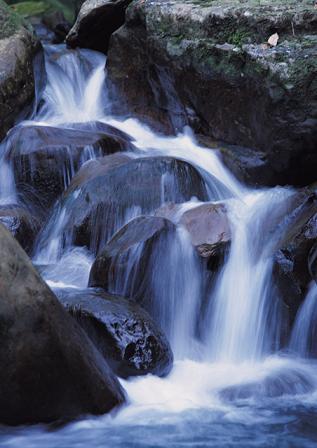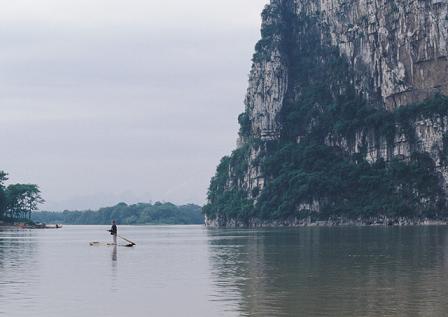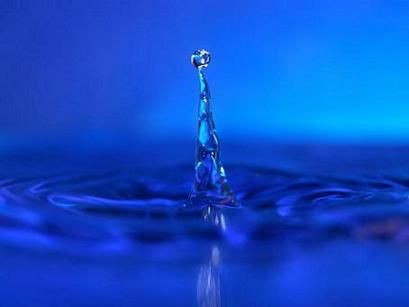| When you turn on a faucet, you expect clean, pure water to flow out. You also expect your city to have plenty of water for its industries, for fighting fires, and for cleaning streets. The job of supplying a modern city with water is tremendous. First of all, there must be sources of plentiful water to meet the demands of a growing city. Then, the water must be purified. Next, it must be piped into every house, office building, factory, and hotel in the city. Finally, the used water must be piped away.
Sources of supply.
Cities can draw fresh water from only two sources: (1) rivers and lakes, or (2) the ground. Smaller cities, especially those with fewer than 5,000 people, get water from underground supplies. Most larger cities get theirs from rivers or lakes.
|

|
Rivers and lakes.
Most cities that depend on rivers for their water are located on small rivers-simply because most rivers are small. The amount of water in a river can vary from time to time, depending on the rainfall. During a dry spell, a river's water level may fall sharply. Then, a city may not have enough water. For this reason, many cities that depend on rivers store water during rainy periods so they will always have a good supply. Some cities build a dam on the river and store water behind it in a reservoir. Others store water in a pond or small lake.

A city that draws its water from a lake has a natural storage reservoir in the lake itself. Lakes are fed by rivers and by waters moving through the ground. During wet spells, lakes store some of the extra water they receive. This extra water helps keep lake levels from dropping below normal during dry periods.
Ground water.
Many cities are not near rivers or lakes large enough for their needs. They use water that is stored underground. This water comes from rain that soaks into the ground. As it trickles downward, it fills the spaces between grains of sand and cracks and pores in rocks. In time, the water reaches a layer of rock or other material that is watertight. The water collects above the watertight layer, and the ground becomes saturated (soaked). This saturated zone is called an aquifer. The upper limit of the zone is called the water table. Cities obtain underground water by drilling wells that reach below the water table and pumping up the water.
Uses of city water supplies.
Most of the water that is supplied by public waterworks goes to people's homes. The waterworks also deliver large amounts of water to commercial users, such as hotels and restaurants, and to manufacturers. City water systems also provide water for fighting fires, cleaning streets, and sprinkling park lawns.
Another "use" of a city's water is waste. In many cities, homeowners pay a flat fee, no matter how much water they use. They do not have meters that measure the water they use. If their faucets leak, the water is wasted. Water is also wasted through leaks in a city's underground pipes. Generally, water lost through leakage is 10 to 15 percent of a city's water use. Chicago loses about 130 million gallons (490 million liters) of water daily through waste.
Purifying and treating water.
People want drinking water that is free of bacteria, sparkling clear, and without an objectionable taste or odor. Water in its natural state seldom has these qualities. So after water is drawn from a source, it is piped into a treatment plant. The plant may put the water through one or several processes, depending on the quality of the untreated water, and on a city's standards. Many cities use three basic processes: (1) coagulation and settling, (2) filtration, and (3) disinfection.
Coagulation and settling.
The raw (untreated) water flows into the treatment plant and is mixed with chemicals. Some of these chemicals are coagulants. The most widely used coagulant is a fine powder called aluminum sulfate or alum. In the water, the alum forms tiny, sticky globs called flocs. Bacteria, mud, and other impurities stick to the flocs. The water then passes into a settling basin, where the flocs settle to the bottom. Coagulation and settling remove most impurities.

Filtration.
The water is then passed through a filter. The filter consists of a bed of sand, or of sand and coal, usually about 21/2 feet (76 centimeters) deep on top of a bed of gravel about 1 foot (30 centimeters) deep. As the water trickles down through the filter, any remaining particles are screened out. The water then flows to huge reservoirs for a final treatment that kills bacteria.
Disinfection kills disease-carrying bacteria. Most plants disinfect water by adding a substance called chlorine. Chlorine sometimes is added before coagulation and settling, and often after filtration. Most cities chlorinate their water, even if they do not treat it in any other way.
Other processes are also used to remove unpleasant tastes or smells, or to give water special qualities. Aeration improves taste and odor. In this process, water is usually sprayed or trickled through the air. The oxygen in the air takes away the bad taste and odor. Many communities have water containing minerals that make it hard. Hard water requires lots of soap to make a lather. It also forms deposits on pipes and other equipment. Several processes can be used to soften the water. Some cities add lime or soda ash to their water to help prevent pipes from rusting. Activated carbon helps improve the taste and odor and remove toxic chemicals. Many communities add a substance called fluoride to their water to help reduce tooth decay.
Distributing water.
The treated water flows to a pumping station, where it is pumped into large cast iron pipes called water mains. Water mains run beneath the streets. They carry water to every fire hydrant, and connect with smaller pipes that lead to every home, office building, factory, and restaurant. The pumping station sends the water into the mains under enough pressure to carry it to every faucet. This pressure is usually so high that you cannot hold back the water by putting your finger under a fully opened faucet.
Sometimes the demand for water may be too great for the pressure a pumping station can supply. Then, water may only trickle from the faucets. This can happen on a hot summer day when many people in the neighborhood are watering their lawns or filling backyard pools. The water pressure may also fall when firefighters use a large amount of water to fight a fire.
Most cities pump water into elevated storage tanks to help keep their water pressure high at all times. The tanks are built on hills, or they are tall water towers. When water is released from these tanks, gravity pulls the water downward, giving it the pressure to rush through the water mains.
Disposing of used water. Most of the water in our homes is used to carry away wastes. This water, and the wastes it carries, is called sewage. Factories also use water to wash away such industrial wastes as acids and greases. In most U.S. cities, a piping system under the streets carries away the sewage from homes, factories, hotels, and other buildings. This system is called a sewerage system.
Sewage has a bad odor. But more important, it contains disease-producing bacteria. Most cities have treatment plants that clean sewage water and kill the bacteria in it. The treated water can then be returned to a river, stream, or lake.
|
Almost all of the sewage in the United States undergoes some type of sewage treatment. Only a little of the sewage is dumped untreated into rivers. The dumping of untreated sewage causes serious problems for the environment and for cities downstream that take their water from the same rivers.
Contributor: Thomas M. Keinath, Ph.D., Dean, College of Engineering, Clemson University.
..: |
|



